THANK YOU
We want to send a big thank you to those people who have chosen to offer financial support to us, as we learn the language in order to serve as missionaries in Costa Rica. It is a huge encouragement whenever someone sends even a small donation. This reminds us that God has put us on someone’s heart and that this surely means they are praying for us as well. Both are needed. This is a great adventure, but it has many ups and downs – emotional highs as well as tears. Thankfully we are in a school with over a hundred other missionaries, who share stories similar to ours; we support one another. But there is nothing quite like the comfort of the tethers to home. Family, church family and friends – each of these is the greatest support of all. To know that we’re thought of, lifted up in prayer and not on our own is encouragement that goes beyond words. Thank you!
COSTA RICA ~ A DEVELOPING NATION
Most US citizens who have had some exposure to Costa Rica have an opinion about what kind of country it is. People who have visited, thought of vacationing or retiring here want to know the “inside scoop,” so to speak. It is frequently called a third world country and sometimes a second world country, but neither is accurate. What people really mean when they make these assessments is that Costa Rica is somewhere in-between what most North Americans think of as industrialized or similar to the US and that a third world nation is a poor country, whereas a second world is somewhere inbetween. Truthfully, all of these terms are obsolete.
These terms were coined after World War 2 and widely used during the cold war. First world countries consisted of the US and those nations that were its allies, second world countries were the (then) Soviet Union, Communist China and their allies, and third world countries were all the remaining non-aligned and neutral nations.
None of these terms expresses the beautiful heart of Costa Rica’s people, its rich heritage and culture or even accurately depict its government or relationship to the United States. None of these terms touches on the beautiful vistas of mountains and/or beaches or tropical rain forests. None of these terms touches what this nation really is – a developing country.
As Christians, this should be an easy phrase for us to identify with – on a journey, in the process, a work as yet unfinished:

Orchids seen on "paseo"
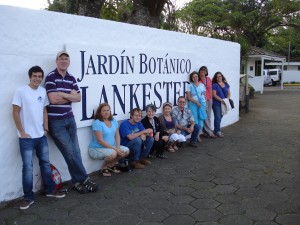
Lankester jardin botanico
Dear friends, now we are children of God, and what we will be has not yet been made known. But we know that when Christ appears, we shall be like him, for we shall see him as he is. 1 John 3:2 TNIV
COSTA RICA ~ THE FACTS, NOTHING BUT THE FACTS
Geography
Area: 19,730 sq. mi. about the size of the states of Vermont and New Hampshire combined.
Climate
Mild in the central highlands, tropical and subtropical in coastal areas.
Trade – Import/Export
The United States is Costa Rica’s main trading partner, accounting for almost half of Costa Rica’s exports, imports, and tourism, and more than two-thirds of its foreign investment.
Costa Rica used to be known principally as a producer of bananas and coffee, but pineapples have surpassed coffee as the number two agricultural export.
Drug Trafficking Partner with the US
The U.S.-Costa Rica Maritime Cooperation Agreement, the first of its kind in Central America, entered into force in late 1999.
Government & Political Conditions
Costa Rica is a Democratic republic, with a very strong system of constitutional checks and balances. It has long standing emphasis of the development of democracy and respect for human rights.
In 2007, the United States reduced Costa Rica’s debt in exchange for protection and conservation of Costa Rican forests through a “debt for nature” swap, under the auspices of the Tropical Forest Conservation Act. This is the largest such agreement of its kind to date – $27 million over 15 years for tropical forest conservation in Costa Rica and another $50 million generated for the conservation, restoration, and protection of the same.
Foreign Relations
Costa Rica is an active member of the international community and proclaimed its permanent neutrality in 1993. Its record on the environment and human rights and advocacy of peaceful settlement of disputes give it a weight in world affairs far beyond its size. The country lobbied aggressively for the establishment of the UN High Commissioner for Human Rights and became the first nation to recognize the jurisdiction of the Inter-American Human Rights Court, based in San Jose.
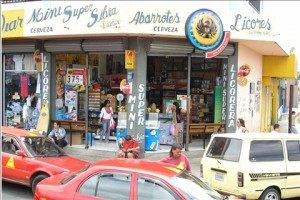
San Jose Traffic (taxis are red)
Roads
Costa Rica completed their portion of the Pan American Highway running from their northern border to their southern border. This network of roads measures about 29,800 miles in total length, except for a 54 mile rainforest break, called the Darién Gap, and links the mainland nations of the Americas in a connected highway system. According to Guinness World Records, the Pan-American Highway is the world’s longest “motorable road”. However, because of the Darién Gap, it is not possible to cross between South America and Central America by traditional motor vehicle. It runs from Prudhoe Bay, Alaska to the lower reaches of South America.
There is a brand new highway known as Autopista Del Sol (Highway of the Sun) that stretches from the beaches around Orotina all the way into San Jose. It took 30 years to build and according to local newspapers was at the tail end of its construction recklessly finished, in order to be ready on time for the presidential elections. And while it is beautiful, it is also frequently closed in the rainy season, due to mudslides and sink
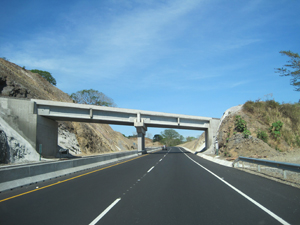
Auto pista del sol
holes. It might also be interesting to know that this highway was built by a Spanish construction country, is maintained by Spain, and the tolls are paid to Spain – an interesting situation when you consider that Costa Rica became independent from Spain, September 15, 1821.
Since we’re speaking about roads, we should probably add that on a day to day basis, we have become human players in a real live game of Frogger. For those of you who don’t know what this game is about, Frogger is an arcade game introduced in 1981. The object of the game is to direct frogs to their homes one by one. To do this, each frog must avoid cars while crossing a busy road. So, in keeping with this game, we dodge traffic to cross busy roads all the time, often needing to come to a screeching halt in the middle of the intersection to wait and make a run across the next lanes of traffic. Only once have we been forced to walk down the center line, with trucks an arm’s length away to either side. This sounds more dangerous than it is. There are many Ticos out there with us and often a vendor or 2 selling their wares; even the occasional hand pushed ice cream cart. It’s all part of the adventure.
Addresses
There are no formal street addresses in Costa Rica, but two informal systems exist. The first (often used in tourist information) indicates the road on which the establishment is located (e.g., “6th Avenue”), together with the crossroad interval (e.g., “between 21st and 23rd Streets”). In practice, street signs are virtually non-existent, and typically, Ticos do not even know the name of the street they are on. The second system, which is much more reliable and understood by the Costa Rican people, is known as the “Tico address,” usually involving an oriented distance (e.g., “100 meters south, 50 meters east”) from a landmark (e.g., “the cathedral”).
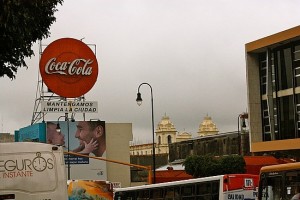
Coca Cola area of San Jose
Few buildings are numbered. And it is important to remember that a city block is considered to be 100 meters long regardless of its length. Therefore, “trescientos cincuenta metros sur del Gran Hotel,” literally 350 meters meter south of the Grand Hotel, and should be interpreted as “three and a half blocks south of the Grand Hotel.” And it really is important to remember that Tico addresses often refer to landmarks that no longer exist too. The most popular imaginary reference point is the Coca Cola bottling plant, which was torn down years ago. Even we use this as a reference point – everyone knows where it is and the whole area is the Coca Cola area – there’s even a giant Coca Cola sign.
This is a great time to remind you of our address, to help you understand how addresses are very different here. We currently have to provide this address to taxis and authorities for our paperwork: Zapote, San Jose, Terminal des Buses, 50 metros oeste, 175 metros sur, en casa blanca. You see, the United States is all about efficiency and precision, whereas Costa Rica is all about relationships – people to other people, and yes, even address to address. Pick up a little book (or download it on your Kindle) and read: Foreign to Familiar: A Guide to Understanding Hot – And Cold – Climate Cultures. It’s a short little book. It will make you laugh and it will give you a whole new understanding of the world around you, as you reach out to people in your community with God’s love, who don’t have the same US cultural background that you do, and nor should they.
TRANSPORTATION ADVENTURES WITH LES & DI

Costa Rica Buses
For transportation, we have become experts (defined loosely) at hoofing it and consider ourselves adventurers on the Costa Rican bus system, with periodic rescues from the also vast network of taxis. The public transportation system is extremely large, very inexpensive and a complete mystery to most “gringos.” Road are often in terrible condition, but are taken in good spirit by all. This keeps it interesting, as you often need to stand on buses during busy times of the day. They are often full – this means every seat and every square inch of the aisles is full to capacity.
However, traveling even short distances can take a very long time. To avoid potholes, drivers often snake through the left and right lanes, usually returning to the right when oncoming traffic approaches. While this may seem erratic, you do become quickly accustomed to it. Traffic lights and highway signs appear to be mostly suggestions and so we have come to see traveling as a great adventure – even if we only travel from the southeast portion of San Jose to the southwest area – a journey that took us an hour and a half just last week … one way, as we headed to the US embassy for the next step in obtaining our Religious Visa.
People do not expect to get anywhere quickly. There are always slow cars/buses/trucks on the road. This causes a lot of crazy driving, which we are told you begin to emulate if you are in-country for any length of time. We have yet to try that theory out, as we do not own a car in Costa Rica and walking and public transportation is all we’ve experience.
Although taking the buses is a venture into the unknown, we often think it might be more efficient than driving, as there are few road names and road signs are relatively few. We are told that there are GPSs, but they don’t help much. Our research indicates that towns generally do not have town-limit signs; it is best to look at the names on the roadside food stores and restaurants to determine the place you are passing.
Of course traveling, even on buses is a great opportunity to ask strangers questions and to practice your Spanish. This may seem strange to North Americans, where people typically maintain a “cone of silence” with their neighbors. In Costa Rica, people, even strangers are usually helpful. Just the other night, trying to get to a church for a Valentine’s Day Couples dinner, we got on the wrong bus with some friends. However, soon thereafter, the bus driver, after calling out to a bus completely full of Ticos, most of who were very happy to give their input, determined that we were on the wrong bus. ( Let’s face it, no matter how hard we try, we just look like gringos.) He was concerned we might be on the wrong bus, so he asked his passengers if one of the bus stops was at La Vina del Este (not unusual – the bus that does take you there doesn’t know that this is one of its stops). Several cell phone calls later (oh – not by us … by the bus driver) he determined that we should be on the bus in front of us. So our current bus raced up to the tail of that bus and after much honking of horns, he let us out and waved good bye. We ran up to the next bus, who proceeded to let us know that it didn’t go where we wanted either.
We caught a taxi.
The Old and the New – Costa Rica and Les & Di
Our lives as Christians shouldn’t make it hard to understand – this is all about the journey and not about the destination. So Costa Rica as a developing nation, with its unique cultural features, continues its journey of change, so too, Les and Di, rich in our US traditions and culture, continue to change.
It is obvious when walking about San Jose, both in the city itself and in its outskirts, that there is a strong mix of old and new. Both are accepted, both have a place, and if they don’t always mesh perfectly, that’s OK too.
Pipes here are small, so used toilet paper is thrown in the trash can next to each toilet, rather than flushed (the old), but a refrigerator can have a water dispenser with ice or crushed ice (the new). You can choose to shop in the Mercado Central (the old) – with everything from meat markets, fish marts, hanging dried herbs, and herbal medicines, to Jansen backpacks, sandals and a large selection of “sodas” (think 1950’s lunch counters in a department store), where you can get a very inexpensive and delicious lunch, and the waitresses fight over which “establishment” and even which table you sit at. It’s noisy, it’s crowded, it’s full of smells (good and bad) and lots of fun; and of course you can find great deals too. It’s an all- under-one-roof – the forerunner of a small mall. You will have to pay 200 colones for toilet paper to use in the bathroom however (the old again). Right around the corner however, is a brick paved enormous walk way with modern stores everywhere, reminding you a bit of shopping in Boston, where everyone is walking, stopping for some Starbucks (“Tostadas,”) shopping and going about their business, while street vendors are calling out there wares, which are displayed on makeshift tables and spread out on blankets on the ground.
If you’re walking to the Multi Plaza del Este or the nearby chocolate factory (it’s delicious dark chocolate and comes as a 1/2 kilo or whole kilo), from the southeast outskirts, you’ll probably cut through the parking lot of the bull ring (the old and new) to get to a very modern and beautiful mall, with things like GNC (just in case you didn’t buy herbal products at the Mercado Central). If it’s a Saturday, there are 400-500 stalls being set up for Zapote’s feria on Sunday. This is an enormous farmer’s market with incredible deals on fresh fruits, vegetables for sale – each vendor competing with their neighbor. As the day wears on, be prepared to bargain for the best price (the old – but make sure you understand the monetary system of colones, offer a fair price that’s lower than the asking price). For those who find the Zapote feria overwhelming, there’s another feria a half hour walk to the south in San Francisco de Dos Rios, which is held on Saturdays. It only has about 40 stalls and is a lot of fun too.
A Clash Between the Old and the New
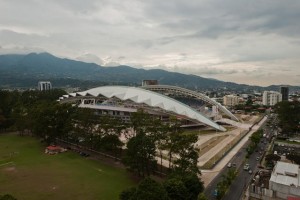
Soccer (Fútbol) Stadium
You don’t have to be a rocket scientist to understand that all soccer in Costa Rica (futbol) is a national pastime and a national passion. Construction on the new $100 million dollar National Stadium in San José’s La Sabana Park is nearly finished. It’s being built by a Chinese Construction company, Anhui Foreign Economic Construction, primarily with Chinese government funding and is a gift to the Costa Rica people, as China works at strengthening its relationship and ties to this nation. The stadium’s alluring design belies a fundamental flaw: to date only 200 parking spaces are ready for a capacity crowd of 35,000 people and inauguration festivities start March 29 with a friendly soccer match between La Sele and Argentina. And no parking plans yet exist, so parking at Costa Rica’s new and modern National Stadium in western San José remains an unsolved riddle.
So, it is obvious that Costa Rica continues to develop as a nation, growing and changing. There’s the new and the modern being built, and there are still hand drawn carts moving furniture down a main street (we watched one just this week). So too, we continue to see God at work in our lives. Breaking us out of old routines, in favor of new – school at 7:30 AM to a little after 12:00. We exchange being adults in favor of receiving a blessing from our Tica Mami as we walk to school wearing salveques (backpacks) and we struggle to learn a new language in our 50s, like the youngest of our grandchildren. We forge new relationships and friendships, while tightly holding onto and cherishing our old ones. And most importantly, we remember that we serve the King of Kings and:
Dear friends, now we are children of God, and what we will be has not yet been made known. But we know that when Christ appears, we shall be like him, for we shall see him as he is. 1 John 3:2 TNIV
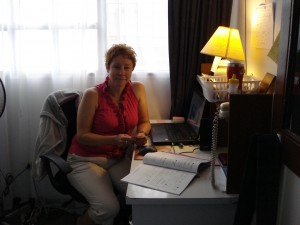
Diana Studying in Oficina
 Les Studying in Oficina
Les Studying in Oficina








